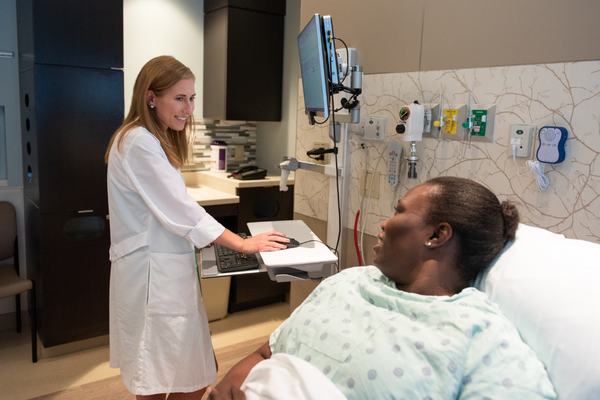Clinician Education
|
These resources are designed to help clinicians learn key considerations for the optimal use of antimicrobials for Northwestern Medicine patients.
Resources for Clinicians
General Resources
Pathogen Resources
Non-Visit-Based Antibiotic Resources
For clinicians and Office staff
As clinicians and office support staff, sick patients often look to you for immediate relief. You are all providing outstanding patient care with the situations you encounter. It’s understandable not all cases are easy and you’re all dealing with more than one patient and more than one problem. These resources are meant to empower you to prescribe non-visit-based antibiotics appropriately while continuing to provide the best care possible. Teaching Tool: This teaching tool is an introduction to non-visit-based antibiotic use that can be used individually or in a one-on-one setting for improved, judicious non-visit-based antibiotic use. Clinical Scenario E-Flashcards (PPT): These electronic flashcards can be used to rapidly review non-visit-based antibiotic use best practices with clinical scenarios given. Resource List (PDF): A list of resources on antibiotic use, outside of Northwestern non-visit-based antibiotic use research, and effective patient communication. Evidence Summary (PDF): Provides detailed evidence on non-visit-based antibiotic use research. For Health Administrators and Leadership
Health administrators and leaders are pivotal in setting the standard for exceptional patient care and safety. These resources will aid leadership in supporting valued clinicians and support staff. Health Leaders Engagement (PDF): Information on how health administrators and leaders can partner with clinicians to make patient safety easier related to non-visit-based antibiotic use. Measure non-visit-based antibiotic use at your clinic: In the section above, read how you can start measuring non-visit-based antibiotic use at your clinic. Non-Visit-Based Antibiotic Use and Measuring
non-visit-based antibiotic use
What is non-visit-based antibiotic use? Non-visit-based antibiotics are antibiotics prescribed in the absence of a face-to-face visit. Antibiotics may be called into pharmacies or prescribed as part of a telemedicine visit. Traditional methods of measuring antibiotic prescribing and addressing inappropriate antibiotic prescribing have not captured non-visit-based antibiotic prescribing. We have found that non-visit-based antibiotics account for about 20% to 30% of ambulatory antibiotic prescribing. The Centers for Disease Control and Prevention Antibiotic Threat Report states that “stopping even some of the inappropriate and unnecessary use of antibiotics in people...would help greatly in slowing down the spread of resistant bacteria.” Antibiotic-resistant infections annually sicken 2 million Americans and kill 23,000. In addition, antibiotics are a major cause of ambulatory adverse drug events. Patients who take antibiotics for viral respiratory infections are more likely to have an adverse drug event requiring an emergency department visit than have an infectious complication prevented. The non-visit-based antibiotic toolkit is to help physicians, other clinicians, health system leaders, payers, stewardship programs, and other stakeholders:
Measuring non-visit-based antibiotic use
To measure non-visit-based antibiotic prescribing, you will need to measure all antibiotic use in your practice or in your data. You can do this using an electronic health record, claims data, or a manual review of antibiotic prescribing. Please note:
Electronic health record prescribing
These methods mirror work that we have done measuring non-visit-based antibiotic prescribing at Northwestern Medicine. 1. Identify all antibiotic prescriptions in your EHR List of antibiotics in the EHR:
(Optional) Identify antibiotics associated with chronic diagnoses: Some non-visit-based antibiotic prescriptions might be associated with patients who have chronic reasons for receiving non-visit-based antibiotics, like recurrent UTIs or COPD. Download this resource to identify the proportion of antibiotics associated with chronic diagnoses in the prior year (XLSX). 2. Identify visit-based antibiotic prescriptions Visit-based antibiotics will have a same-day, in-person visit as the antibiotic prescription. Although you may have others in your EHR, in-person visit types may include the following encounter types:
(Optional) Assess the appropriateness of antibiotic prescriptions: ICD-10 Appropriateness Codes: We have a list of the antibiotic-appropriateness of all 90,000+ ICD-10 codes that you can associate with in-person or non-visit-based prescribing. ICD-10 diagnosis codes have been classified as “always” infection related (A), “sometimes” infection related (S), or “never” infection related (N). 3. Describe non-visit-based antibiotic prescriptions Although you may have others, some examples of non-visit-based encounters include:
You can describe what proportion of non-visit-based antibiotic prescriptions are associated with each encounter type. medication insurance claims
These methods are similar to the method of Fischer and Colleagues (Health Affairs, in press) to measure the proportion of antibiotic fills that are non-visit-based. 1. Identify All Antibiotic Fills Using whatever medication standard you have available, identify commonly prescribed, absorbable oral antibiotics. Download this resource for a full list of antibiotics or this resource for a succinct list. 2. Identify In-Person Visits Prior to Antibiotic Prescribing Using Current Procedural Terminology, 4th Edition (CPT) or Healthcare Common Procedure Coding System (HCPCS), label antibiotic prescriptions as having a visit in the prior 7 days. We have a list of CPT and HCPCS codes here that are associated with face-to-face visits. 3. (optional) Assess the appropriateness of in-person antibiotic prescribing Using diagnosis codes on the day of or in the prior 7 days, determine if the antibiotic is appropriate, potentially appropriate, or not appropriate.
4. Describe Non-Visit-Based Fills With these remainder antibiotics you can describe the proportion of all antibiotics they account for, antibiotic classes, individual antibiotics, and, if you have prescriber data, characteristics of the prescribers and how any of these factors differ from in-person antibiotics. manual tracking of antibiotic prescribing
If you do not have access to electronic health record data or claims data, you may have to manually sample charts to know how much antibiotic prescribing in your practice is non-visit-based. Some clinics traditionally did not record prescriptions that were “Called In” to the pharmacy. |
PATIENT EDUCATION
Find patient handouts and CDC resources, which can help educate patients about antibiotic resistance. AMBULATORY CARE RESOURCES
Find guidelines and clinical decision support tools for Northwestern Medicine Ambulatory Care sites, including Immediate Care Centers. Educational Videos
Watch the ADSP team videos to learn about topics related to the optimal use of antimicrobials. |




